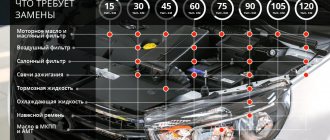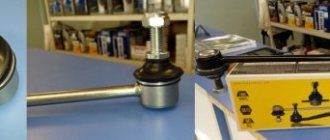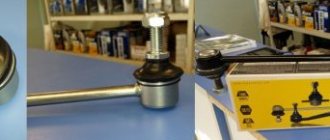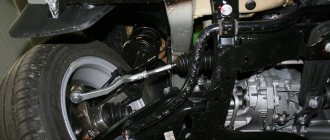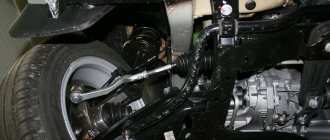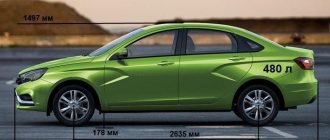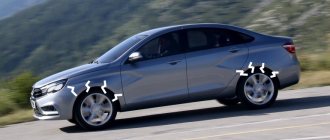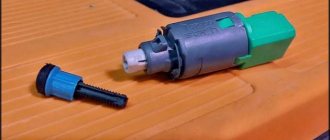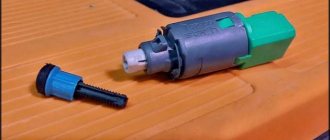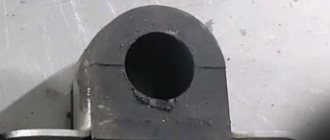Even at the stages of car development, it was known that the Vesta platform would be truly new, and not just another modernization of the VAZ 2108 suspension. Now that serial production of the sedan has already started, and the first samples have already been on test drives in various car magazines, more detailed details are being clarified about the chassis of the Lada Vesta.
The last adjustments to the suspension characteristics took place in winter in Spain, at the IDIADA training ground. Then a balance was found between comfort and car controllability. What happened?
Lada Vesta front suspension design
The supporting structure is based on a subframe, which is an innovation for the domestic automobile industry. Also, for the first time, the L-shaped levers were used.
The subframe performs the additional function of strengthening the body, giving it strength, and preventing deformation on uneven surfaces. As a result, the overall safety score was increased by five points.
In general, the suspension design is quite simple and in many ways similar to Renault Logan and Renault Duster of the second generation. Carrying out preventive maintenance does not require additional costs. The steering gear is now secured to the bottom of the engine compartment.
Independent suspension
From a physical point of view, the “low” position of the rack provides maximum connection with the steering knuckle. An electric amplifier is pre-installed on the rail, which was not previously in the design of VAZs. The shape of the transverse stabilizer has been redesigned to improve the “feel” when turning the steering wheel. The castor (tilt) angle is 5°, independent suspension, MacPherson struts, which together make the car smoother.
What is the difference between station wagons and trim levels?
Additional options that only Lada Vesta SW Cross has:
- Original off-road body kit.
- Body color "Mars" (orange, 130).
- Interior color (orange trim).
- Decorative exhaust pipe nozzle.
Unfortunately, many cars produced by AVTOVAZ have problems with the chassis. The new Station Wagon models have a redesigned and improved suspension, mainly focusing on the front part of the part. The car boasts L-shaped levers. To create them, high-quality steel, a high-strength body and a subframe were used.
Rear suspension device
The food is borrowed from the French brand Renault Logan of the second generation. The design is typical - a transverse metal beam with springs spaced on the sides.
The brake system is of a drum type, which was expected, since disc mechanisms would increase the cost of the model by 3 - 4%. In general, the “drums” do an excellent job of the task at low and medium speeds.
Design (diagram):
- Levers.
- Gaskets for springs.
- Upper support.
- Compression buffer.
- Gas shock absorber.
- Hub axis.
- Brake drum.
- The wheelbase is extended to 1510 mm.
Comparison by characteristics
Lada Vesta enters the market as a sedan. The Lada Vesta Cross modification has a station wagon body and increased ground clearance (203 mm versus 178 mm). Equipped with gasoline engines with a capacity of 106 and 122 hp. With. volume 1.6 and 1.8 liters. Two types of transmission: 5-speed manual and 5-speed robotic automatic transmission provide acceleration in 11.2 and 13.3 seconds to 100 km/h. Maximum speed is 186 km/h. For AI-92 gasoline, a 55-liter tank is provided.
In the Standard standard package, the car owner receives:
- front airbags (with passenger side deactivation);
- blocking the rear doors from opening by children while driving;
- emergency warning system ERA-GLONASS;
- ESD, ABS, EBD, BAS (braking assist system), ESC (electronic stability control system), TCS (traction control system), HSA (hill start assist system);
- height and reach adjustable steering column.
Car appearance
The design of LADA Vesta compares favorably with all previous AvtoVAZ models. The future appearance of the Lada was shaped by the British designer, author of popular models from the Mercedes-Benz and Volvo brands, Stephen Mattin. The modern, recognizable appearance of LADA Vesta is not inferior to the appearance of its competitors. The choice is determined only by the taste of the buyer.
Interior of competitors
In the basic configuration, the interior decoration of all presented cars differs little from each other. These include fabric upholstery for seats and armrests, an on-board computer showing air temperature, engine speed and mileage, a 12 V socket in the front, a case for glasses, door lights and front power windows.
Specifications
The weakest engine in the line is the Skoda Rapid - 75 hp. With. This is a good option for a small car for getting around the city. The Volkswagen Polo engine with 1.6 liter gasoline is one of the best in the database. Everyone has the upper limit except Renault Logan, with its maximum 113 hp. s., approximately at the same level - 122-125 l. With. At the same time, fuel consumption is the same, which indicates the quality of the power plants used.
Manufacturers recommend filling the tank with gasoline of a grade no lower than AI-92.
The Volkswagen Polo has the greatest variety of gearboxes: 2 manual and 2 automatic options. LADA and the Korean Kia Rio and Hyundai Solaris are in the middle of this rating, because An alternative to one manual transmission option is one automatic transmission.
The combination of engine and transmission makes the Skoda Rapid and Volkswagen Polo the most dynamic of the list, accelerating to 100 km/h in less than 10 seconds.
The vehicles are equipped with front disc and rear drum brakes. Luxury models can have rear disc brakes.
The Russian sedan has more ground clearance - almost 180 mm versus 160 mm for Korean cars and 155 mm for the French model. The Skoda Rapid has almost 8 mm less ground clearance, while the Polo has 150 mm.
Review and comparison of technical characteristics allows us to talk about approximate equality of competitors.
Comfort and safety while driving
In terms of the number of airbags in the database, Renault Logan is the worst - it does not have them. Other manufacturers have provided protection for the driver and front seat passenger in a frontal collision.
Renault designers considered that auxiliary active and passive safety systems were not needed. In Polo they decided to install ABS enough, and in Rapid - ESC. Korean cars, unlike European ones, have more functions, but Vesta with ABS, EBD, BAS, ESC, TCS and HSA is superior to all car brands considered.
The ERA-GLONASS emergency response system is installed on all vehicles reviewed, except Logan and Rio.
In terms of comfort, Renault loses to other brands. Seat and steering column adjustments are available in the base for all except the French model. The Škoda has the most spacious trunk - 530 liters, with the second row seats folded - 1470 liters. Customer reviews indicate that the level of convenience and ergonomics of the cars in question meet modern needs and demands.
The Lada Vesta Luxe version has a rain sensor: the speed of the wiper blades automatically adjusts to the amount of precipitation falling on the windshield. When the intensity of rain or snow constantly changes while driving, the ability to not be distracted by manually adjusting the wipers is of great importance.
What's new: about built-in technologies and stabilization system
In addition to the above innovations, we additionally note the presence of systems:
- ABS;
- ESP;
- EBD;
- electric power steering wheel from the Japanese concern Nissan;
- braking system from French Renault.
The stabilization system controls the vehicle's traction, which makes it easy to overcome various drifts and obstacles while driving.
You can significantly improve the vehicle's maneuverability by simulating a differential lock. In Lada Vesta such a system is configured very effectively. Now the car is not “afraid” of dirt, bumps, or wet roadsides. When the mode is activated, the electronics enter the “all-terrain” phase. It is not recommended to use this mode on an ongoing basis.
How to reset errors on Vesta
After diagnosing and troubleshooting, it is necessary to reset the on-board computer errors for its normal operation in the future. If everything is left as is, the vehicle’s on-board systems may operate intermittently even in good condition.
Typically, on simpler modifications of the manufacturer, the numbers are reset by resetting the on-board computer counter or removing the battery terminals.
Lada Vesta errors are reset only when a diagnostic scanner is connected. The special program provides the ability to fully manage and monitor on-board systems in terms of electronics. By going to the appropriate settings section, the wizard can eliminate all error codes and failures from the device’s memory.
What are the advantages of the new Lada Vesta suspension?
- The suspension concept has been radically changed. The supporting structure is based on a subframe at the bottom of the engine compartment;
- increased rigidity;
- compliance of body geometry with standards;
- improvement of vibro-acoustic properties;
- steering rods are directly connected to the hubs;
- castor (tilt) angle is 5°;
- MacPherson struts;
- upgraded anti-roll bar;
- maximum adaptation for domestic roads.
Conclusion
The average resource of the front and rear suspension of a car is designed for 90,000 km and above. If you follow the manufacturer's recommendations, take care of the equipment, and moderate speed conditions, the replacement interval for parts can be increased to 120 - 130 thousand km.
Carry out preventive work at certified service stations, where they provide a guarantee. If you have experience, practice repairs yourself, but this should not conflict with the requirements of the warranty. Buy spare parts mainly from domestic manufacturers. The quality of the components is not inferior to foreign analogues, and the price is 25–30% cheaper.
Reviews
| № | Positive |
| 1. | Dmitry Vasilyevich , 43 years old (otzovik.com): the suspension is mounted on a subframe, a new form of levers, steering knuckles. Road obstacles are overcome without impact. |
| 2. | Arkady Semenovich , 39 years old (www.zr.ru): there are no complaints about the suspension at speeds up to 120 – 130 km/h, it works quickly and softly. At higher modes, there is a decrease in control efficiency, the car rolls when entering turns. |
| 3. | Kirill , 22 years old (autobann.su): control is sharp due to the fact that the rack is pre-installed on the subframe and has an indirect connection with the steering knuckles. |
| 4. | Matvey , 33 years old (lada-vesta.net): on previous modifications of the Lada, the chassis, suspension, and steering mechanism were worse. I can compare, since before the Lada Vesta there was a Priora and a Granta. |
| 5. | Vasily Petrovich , 43 years old (otzovik.com): my positive review of the chassis and suspension of the Lada Vesta. I've been using the car for three years now, no complaints. |
| 6. | Pyotr Semenovich , 45 years old (www.zr.ru): for me, as a resident of a rural area, you can’t find a better car. I'm happy with the purchase, no complaints. I fix minor breakdowns on my own without going to a service station. |
| 7. | Sergey , 20 years old (autobann.su): rear springs and shock absorbers have become softer compared to the Lada Granta. Minor unevenness is silently absorbed. For our imperfect roads, this is what we need. |
| 8. | Saveliy Petrovich , 43 years old (lada-vesta.net): the vehicle’s ground clearance allows it to overcome many obstacles without reducing speed, detours, or maneuvers. This is very good for city roads when the car follows the flow. |
| 9. | Dmitry , 30 years old (otzovik.com): my positive review of the Lada Vesta, there are no critical comments, and I fix minor breakdowns on my own. |
| 10. | Nikolai Petrovich , 43 years old (www.zr.ru): there are no comments on the components, I systematically carry out technical inspections, diagnostics, and treat equipment with care. The car is three years old, the condition of a new car. |
| 11. | Alexey , 35 years old (autobann.su): replaced the bushings in two years, checked the wheel alignment. I'm pleased with the build quality, my recommendations to motorists. |
| Negative | |
| 12. | Vitaly Nikolaevich , 43 years old (www.zr.ru): in the first year of service, replaced the chassis bushings. The shock absorbers began to leak and the springs began to creak. |
| 13. | Leonid , 27 years old (otzovik.com): after 35,000 km, replaced the standard stabilizer seals with polyurethane ones. The manufacturer saves on materials and installs the cheapest ones. |
| 14. | Arsen Mikhailovich , 45 years old (autobann.su): the model needs to be improved and defects eliminated. It’s better to wait a while or buy a second generation Renault Logan. |
The upper “bar” of front-wheel drive VAZs
In this paragraph, we will briefly consider those technological innovations that were implemented along with the release of the first front-wheel drive cars. Further, it becomes incomprehensible to the Russian consumer why the design solution regarding the design of the car suspension has not changed for decades, as if remaining an insurmountable bar.
Were the ideas too successful? Or VAZ did not risk increasing the cost of a car that was already losing its position. But the fact remains: the suspension design of the VAZ 2108 - VAZ 2170 is practically no different.
To fully appreciate the efforts of AvtoVAZ designers, let’s look at some of the “sores” that the concern faced in 2015. The suspension cannot be called unsuccessful, since the entire line from the “Eight” to the “Priora” will have its fans.
But on the threshold of the 21st century, it was necessary to solve some problems that were turning our cars into Soviet-era cars. While the French or, for example, the Germans made full use of the technology of damper flywheels and pulleys, and also transferred a significant part of the load from the body to the subframe, domestic cars continued to actively respond to the slightest irregularities on the road.
The MacPherson suspension may have provided the required level of reliability, but without significant modifications it was extremely stiff, flimsy, and showed disgusting stability results on the highway.
What saved the strut from longitudinal displacement was a trivial stretcher, which in the front part of the car, at best, rested against the beam using a silent block. In the worst case, we remember the tears of car owners replacing broken aluminum “crabs”. Certain shortcomings were also identified in the design of the upper support. Along with low reliability, we inherited constant bearing knocking, which became an incurable “disease”.
This is interesting: Problems with the Lada Vesta suspension: creaks, noises, knocks


